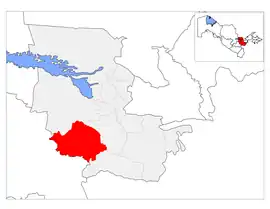Gʻallaorol District
Gʻallaorol | |
|---|---|
| Gʻallaorol tumani | |
 | |
| Country | Uzbekistan |
| Region | Jizzakh Region |
| Capital | Gʻallaorol |
| Established | 1926 |
| Area | |
| • Total | 1,950 km2 (750 sq mi) |
| Population (2020) | |
| • Total | 173,000 |
| • Density | 89/km2 (230/sq mi) |
| Time zone | UTC+5 (UZT) |
Gʻallaorol (Uzbek: Gʻallaorol tumani, Russian: Галляаральский район) is a district of Jizzakh Region, Uzbekistan. The capital lies at the city Gʻallaorol.[1] It has an area of 1,950 km2 (750 sq mi)[2] and its population is 173,000 (2020 est.).[3]
Settlements
The district consists of one city (Gʻallaorol), 6 urban-type settlements (Marjonbuloq, Qoʻytosh, Lalmikor, Qangliobod, Abdukarim, Chuvilloq) and 14 rural communities (Gʻoʻbdin, Xonimqo'rg'on, Ittifoq, Gulchambar, Qipchoqsuv, Koʻkbuloq, Korizquduq, Guliston, Buloqboshi, Madaniyat, Mirzabuloq, Moltob, Tozaurugʻ, Mulkush).[1]
Population
It has a population of 173,000 people. The average population density is 89 people per km2. The urban population is 60.9 thousand, the rural population is 112.1 thousand people.[4]
Geography
Topography
The central and western part of the Gʻallaorol district is composed of plains, with high mountain ranges and mountains. The district is surrounded by Nurata Range from the north and the Molguzar Mountain in the east. It borders with Jizzakh, Bakhmal, and Forish districts of Jizzakh Region and with Buklungur, Jomboy, and Kushrabot districts of Samarqand Region to the west.
Geology
The most parts of the Gʻallaorol district is formed by plains consisting of loess and yellow soil layer, moving from 380 to 400 meters to the north of 1600-1900 meters to the north. This plain, formed by the Sangzor River, dates back to the Nurata mountain range. The soil in the central and northern part of the hillsides is a greasy, opaque, typical gray soils formed on the soil. The territory of the district is rich in mineral resources such as lead minerals, zircon, zinc and gold. There are sand, gravel, gypsum, granite, limestone and other homogeneous construction materials of local significance. The district also profits from mineral water supply.
Climate
Climate is sharp continental, dry summer, cold winter. The average January temperature is -2 °C and 32 °C in July. Yearly rainfall is 326 mm. Vegetation period is 240 days.
Economy
In the community and private farms of the district have cattle, sheep and goats, poultry and parrots. There is also a production of cereals, vegetables, potatoes, melons and vine.
Wildlife
The wild-growing plants are tulips, lilac, mulberry, sesame, shoreta, wormwood, spruce, bergamot, among others. The fauna consists of wolves, foxes, hogs, alleys, arches, rabbits; rodents, frogs, poisonous snakes, echinaceae, hawthorn, the moth, the mushroom, the field mouse; eagles, birds, quails, shrubs, doves, pigeons, there are various fishes in the water basins. Some kinds of mushroom also exist.[5]
History
There are several archeological sites dating back until the first century (BC), called Qoʻngʻirtepa, Shaxidtepa, Almantepa, Jalmantepa, Lapaktepa, Pardakultepa, Nushkent.
Established on September 29, 1926, it was called Yangiqoʻrgʻon district until 1931.[6]
References
- "Classification system of territorial units of the Republic of Uzbekistan" (in Uzbek and Russian). The State Committee of the Republic of Uzbekistan on statistics. July 2020.
- "Jizzax viloyatining ma'muriy-hududiy bo'linishi" [Administrative-territorial division of the Jizzakh Region] (PDF) (in Uzbek). Jizzakh regional department of statistics.
- Permanent population of Jizzakh region as of July 1, 2020, Republic of Uzbekistan Open Data Portal
- "Жиззах вилоятининг ижтимоий–иқтисодий ривожланиши, иқтисодиёт тармоқлари ва ҳудудлар ҳолати 2020 йил II-чорак" [Socio-economic development of Jizzakh region, the state of industries and regions in the II quarter of 2020] (in Uzbek). Jizzakh regional department of statistics. p. 113.
- OʻzME. Birinchi jild. Tashkent. 2000.
{{cite book}}: CS1 maint: location missing publisher (link) - "Ғаллаорол тумани" [Gʻallaorol District] (PDF). National Encyclopedia of Uzbekistan (in Uzbek). Tashkent. 2000–2005. pp. 12–13.
{{cite encyclopedia}}: CS1 maint: location missing publisher (link)
